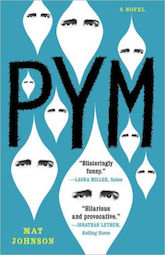In 2016, Fantastic Stories of the Imagination published my survey “A Crash Course in the History of Black Science Fiction” (now hosted here). Since then Tor.com has published 25 in-depth essays I wrote about some of the 42 works mentioned, and another essay by LaShawn Wanak on my collection Filter House. This month’s column is dedicated to Pym by Mat Johnson.
FUNNY PECULIAR
Well known for Incognegro, his not-so-comic graphic novel about a white-passing reporter investigating Southern lynch mobs, Johnson tackles racial politics yet again in Pym. This time the perspective is that of a black academic denied tenure for, among other social crimes, refusing to serve on his university’s diversity committee. Fired English professor Chris Jaynes believes that the proper study of blacks is whites. He’s particularly obsessed with Edgar Allan Poe’s sole novel, The Narrative of Arthur Gordon Pym of Nantucket. Following up on a clue to the ostensible real-life source of Poe’s inspiration, Jaynes pursues firsthand knowledge of Dirk Peters, Pym’s supposed co-survivor of the Antarctic shipwreck with which Poe’s Narrative ends. Jaynes’s wry commentary on ivory tower politics and the antics of a Peters descendant claiming Indian blood provide early touches of humor, and Johnson continues in this jesting vein as his hero assembles an all-black crew to sail to the South Pole. Even the end of the civilized world takes on a comic air as Jaynes et al. escape their useless radios and internet connections only to be enslaved by a bunch of white, yeti-like creatures they dub “snow honkies.”
PECULIAR INSTITUTIONS
Johnson’s Antarctica is a busy place. In addition to Tekelians (the polite name for snow honkies) inhabiting secret under-ice caverns, there’s the climate-controlled dome where famous painter Thomas Karvel hides out. Karvel is a very thinly disguised Thomas Kinkade, and his oversaturated, multihued color schemes represent a different kind of whiteness: the cultural kind. Like Poe, Karvel/Kinkade idealizes the sort of Caucasoid purity which never could have existed: removed from the global history of inventiveness, independent of international trade and labor.
There’s yet another form of whiteness to be found in the cartons of Little Debbie Snack Cakes imported by Jaynes’s childhood friend Garth Frierson. The most soulless of foods, the empty essence of consumer goods, addictive and void of all nutritional value, Little Debbies come to play a pivotal role in the black/Tekelian economy.
INSTITUTIONALIZED CHOICES
Johnson himself is mixed race; the novel’s literally black-and-white take on our world springs from the reduction and disassembling of the author’s own identity. In this country, at this time, we’re still in thrall to the notorious “one-drop rule”: African ancestry is so powerful that it overcomes any white admixture, no matter how dilute the blackness or how blond and blue-eyed the result of the blending. Barack Obama, for example, is consistently called the U.S.’s first black president, though he was born of a white mother.
Buy the Book


Pym
The horrific Tsalalians of Poe’s Narrative are so dark even their teeth gleam with blackness. Countering this image, Johnson gives his Tekelians starkly white gums. He also transforms their supernaturally large size, which could be seen as a mark of superiority, into monstrousness akin to the bestial physicality projected by racist whites onto black athletes, and lampoons Tekelian whiteness in other ways as well.
As a young child, I lived in a predominantly black neighborhood in the small, Midwestern town of Kalamazoo. I vividly remember a babysitter’s explanation of what white people were like, which she offered in answer to my puzzled inquiries. First, she assured me that they weren’t actually white like paper, but then she admitted that their features were sharp, as if they’d been cut from paper—especially their noses. “And their lips are thin, and they don’t hardly ever smile or laugh,” she added. “They really don’t have much sense of humor or know how to relax and have a good time.” True, my own light-skinnedness and the presence of a pair of African American albinos across the street didn’t help matters, but I had a hard time recognizing the grocer on the corner, Mr. Schulz, from this description.
When I realized the mix-up, I suspected what science now confirms: race is simply a convenient social construct. But it’s a social construct that can punish, imprison, torture, and kill you, as many of us know to our sorrow.
In Pym, Johnson makes race his intellectual plaything. He has lots of fun parodying the various ways in which it reinforces its dominance. By the end of the novel, though, he abandons it. Arriving at last on the subtropical Antarctic island of Tsalal, his goal throughout the novel’s adventures, Jaynes discovers not Poe’s race of subhuman black savages but a welcoming “collection of brown people,” women, men, and children, typical inhabitants of “a planet on which such are the majority.”
CHOOSING TO LAUGH
One of speculative fiction’s greatest strengths is its ability to de-familiarize ideas we take for granted. Critic Darko Suvin examined this ability in his scholarly work on the concept of cognitive estrangement. Using his black characters’ encounter with the ultra-white Tekelians as a lens, Johnson both focuses on and distances us from the politics of racially-based oppression. With distance we gain clarity, perspective, and the possibility of treating this notoriously serious social construction as a joke.
Not all stories told by people of African descent have to be about racism. We’re complex. We’re intersectional. We’re people. Mat Johnson has done a heckuva job telling this one, though.
 Nisi Shawl is a writer of science fiction and fantasy short stories and a journalist. She is the author of Everfair (Tor Books) and co-author (with Cynthia Ward) of Writing the Other: Bridging Cultural Differences for Successful Fiction, and the editor of the anthology New Suns: Original Speculative Fiction by People of Color. Her short stories have appeared in Asimov’s SF Magazine, Strange Horizons, and numerous other magazines and anthologies.
Nisi Shawl is a writer of science fiction and fantasy short stories and a journalist. She is the author of Everfair (Tor Books) and co-author (with Cynthia Ward) of Writing the Other: Bridging Cultural Differences for Successful Fiction, and the editor of the anthology New Suns: Original Speculative Fiction by People of Color. Her short stories have appeared in Asimov’s SF Magazine, Strange Horizons, and numerous other magazines and anthologies.











Thank you for this column. I am thoroughly enjoying expanding my to be read pile.
Snow honkies? Now how is that in any way acceptable?